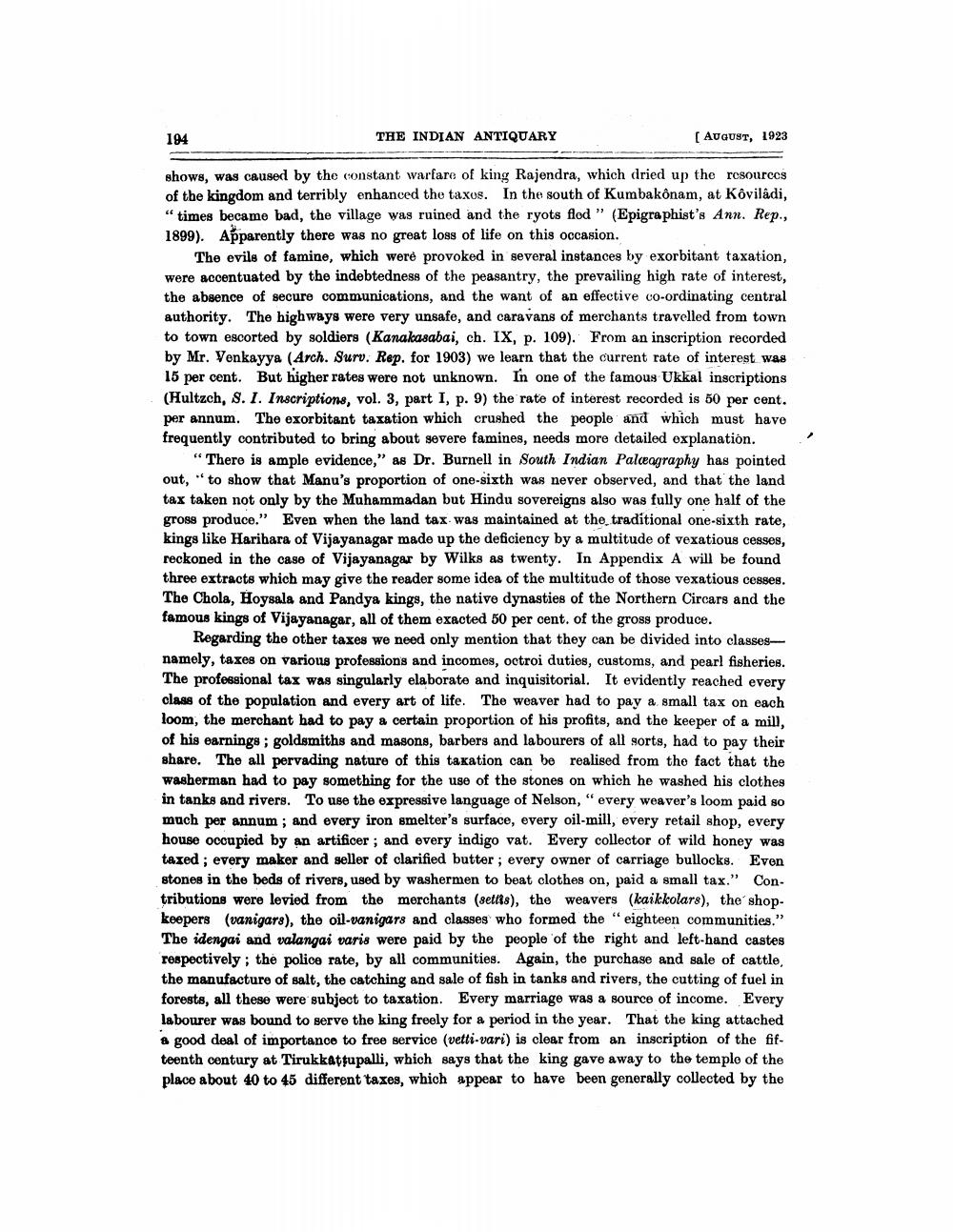________________
194
THE INDIAN ANTIQUARY
(AUGUST, 1923
shows, was caused by the constant warfare of king Rajendra, which dried up the resources of the kingdom and terribly enhanced the taxes. In the south of Kumbakonam, at Kôviladi, "times became bad, the village was ruined and the ryots flod " (Epigraphist's Ann. Rep., 1899). Apparently there was no great loss of life on this occasion.
The evils of famine, which were provoked in several instances by exorbitant taxation, were accentuated by the indebtedness of the peasantry, the prevailing high rate of interest, the absence of secure communications, and the want of an effective co-ordinating central authority. The highways were very unsafe, and caravans of merchants travelled from town to town escorted by soldiers (Kanakasabai, ch. IX, p. 109). From an inscription recorded by Mr. Venkayya (Arch. Surv. Rep. for 1903) we learn that the current rate of interest was 15 per cent. But higher rates were not unknown. In one of the famous Ukkal inscriptions (Hultzch, 8. 1. Inscriptions, vol. 3, part I, p. 9) the rate of interest recorded is 50 per cent. per annum. The exorbitant taxation which crushed the people and which must have frequently contributed to bring about severe famines, needs more detailed explanation.
"There is ample evidence," as Dr. Burnell in South Indian Palcography has pointed out, "to show that Manu's proportion of one-sixth was never observed, and that the land tax taken not only by the Muhammadan but Hindu sovereigns also was fully one half of the gross produce.” Even when the land tax was maintained at the traditional one-sixth rate, kings like Haribara of Vijayanagar made up the deficiency by a multitude of vexatious cesses, reckoned in the case of Vijayanagar by Wilks as twenty. In Appendix A will be found three extracts which may give the reader some idea of the multitude of those vexatious cesses. The Chola, Hoysala and Pandya kings, the native dynasties of the Northern Circars and the famous kings of Vijayanagar, all of them exacted 50 per cent. of the gross produce.
Regarding the other taxes we need only mention that they can be divided into classes namely, taxes on various professions and incomes, octroi duties, customs, and pearl fisheries. The professional tax was singularly elaborate and inquisitorial. It evidently reached every class of the population and every art of life. The weaver had to pay a small tax on each loom, the merchant had to pay a certain proportion of his profits, and the keeper of a mill, of his earnings ; goldsmiths and masons, barbers and labourers of all sorts, had to pay their share. The all pervading nature of this taxation can be realised from the fact that the washerman had to pay something for the use of the stones on which he washed his clothes in tanks and rivers. To use the expressive language of Nelson, "every weaver's loom paid so much per annum ; and every iron smelter's surface, every oil-mill, every retail shop, every house occupied by an artificer; and every indigo vat. Every collector of wild honey was taxed; every maker and seller of clarified butter ; every owner of carriage bullocks. Even stones in the beds of rivers, used by washermen to beat clothes on, paid a small tax." Contributions were levied from the merchants (setts), the weavers (kaikkolars), the shopkeepers (vanigars), the oil-vanigars and classes who formed the "eighteen communities." The idengai and valangai varis were paid by the people of the right and left-hand castes respectively; the police rate, by all communities. Again, the purchase and sale of cattle, the manufacture of salt, the catching and sale of fish in tanks and rivers, the cutting of fuel in forests, all these were subject to taxation. Every marriage was a source of income. Every labourer was bound to serve the king freely for a period in the year. That the king attached a good deal of importance to free service (vetti-vari) is clear from an inscription of the fifteenth century at Tirukkattupalli, which says that the king gave away to the temple of the place about 40 to 45 different taxes, which appear to have been generally collected by the




